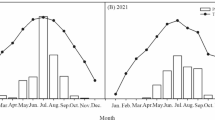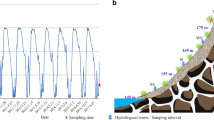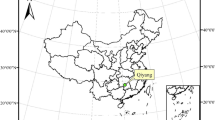Abstract
Purpose
The main objective of this study was to investigate the effects of abiogenic and biogenic factors, and their interaction, on aggregate stability determined at different particle sizes.
Materials and methods
Soil samples with the same land use pattern were collected and fractioned into five aggregate sizes: 10–15 mm, 5–10 mm, 2–5 mm, 0.25–2 mm, and < 0.25 mm. Contents of iron/aluminum (Fe/Al) oxides, soil organic carbon (SOC), clay, and mean weight diameter (MWD) values for aggregates at different sizes were determined. The respective contributions of these factors were further estimated using path analysis.
Results and discussion
The results showed that SOC contents in A horizon declined with the increase of aggregate size. Highest amorphous iron oxide (Feo) contents were observed in 0.25–2 and 2–5 mm aggregates, but highest amorphous aluminum oxide (Alo) contents were found in 5–10 mm aggregates. Abiotic factors (Fe/Al oxides, clay) played a more important role in determining the formation of < 0.25 mm aggregates, whereas both abiotic and biotic factors play an effective role in stabilizing larger aggregates (0.25–2, 2–5, 5–10, and 10–15 mm). The organo-mineral complexes played a certain role in the stability of soil aggregates, especially the larger aggregates.
Conclusions
We conclude that abiotic and biotic factors play variable roles in soil aggregates at different sizes, and more studies are needed to better assess their respective roles to improve our understanding of soil aggregation.










Similar content being viewed by others
References
Almajmaie A, Hardie M, Acuna T, Birch C (2017) Evaluation of methods for determining soil aggregate stability. Soil Till Res 167:39–45
Amézketa E (1999) Soil aggregate stability: a review. J Sustain Agr 14:83–151
Barthès BG, Kouakoua E, MC L´-L, Razafimbelo TM, de Luca EF, Azontonde A, Neves CSVJ, de Freitas PL, Feller CL (2008) Texture and sesquioxide effects on water-stable aggregates and organic matter in some tropical soils. Geoderma 143:14–25
Barto EK, Alt F, Oelmann Y, Wilcke W, Rillig MC (2010) Contributions of biotic and abiotic factors to soil aggregation across a land use gradient. Soil Biol Biochem 42:2316–2324
Boix-Fayos C, Calvo-Cases A, Imeson AC, Soriano-Soto MD (2001) Influence of soil properties on the aggregation of some Mediterranean soils and the use of aggregate size and stability as land degradation indicators. Catena 44:47–67
Bronick CJ, Lal R (2005) Soil structure and management: a review. Geoderma 124:3–22
Chaplot V, Cooper M (2015) Soil aggregate stability to predict organic carbon outputs from soils. Geoderma 243-244:205–213
Chi GY, Huang B, Ma J, Shi Y, Chen X (2016) Vertical distribution of soil Fe in typical riparian subzones of the Sanjiang Plain. Ecol Eng 96:55–62
Denef K, Six J, Merckx R, Paustian K (2002) Short-term effects of biological and physical forces on aggregate formation in soils with different clay mineralogy. Plant Soil 246:185–200
Saygın SD, Cornelis WM, Erpul G, Gabriels D (2012) Comparison of different aggregate stability approaches for loamy sand soils. Appl Soil Ecol 54:1–6
Duiker SW, Rhoton FE, Torrent J, Smeck NE, Lal R (2003) Iron (hydr) oxide crystallinity effects on soil aggregation. Soil Sci Soc Am J 67:606–611
Elliott ET (1986) Aggregate structure and carbon nitrogen, and phosphorus in native and cultivated soils. Soil Sci Soc Am J 50:627–633
Elliott ET, Palm CA, Reuss DE, Monz CA (1991) organic matter contained in soil aggregates from a tropical chronosequence: correction for sand and light fraction. Agricu Ecosyst Environ 34:443–451
García-Orenes F, Guerrero C, Roldán A, Mataix-Solera J, Cerdà A, Campoy M, Zornoza R, Bárcenas G, Caravaca F (2010) Soil microbial biomass and activity under different agricultural management systems in a semi-arid Mediterranean agroecosystem. Soil Till Res 109:110–115
Gee GW, Bauder JW (1979) Particle size analysis by hydrometer: a simplified method for routine textural analysis and a sensitivity test of measurement parameters. Soil Sci Soc Am J 43:1004–1007
Gelaw AM, Singh BR, Lal R (2015) Organic carbon and nitrogen associated with soil aggregates and particle sizes under different land uses in Tigray, Northern Ethiopia. Land Degrad Dev 26:690–700
Gui S, Wu CY, Qu Y, Guo LL (2017) Path analysis of factors impacting China’s CO2 emission intensity: viewpoint on energy. Energ Policy 109:650–658
Haile GS, Nair PKR, Nair VD (2008) Carbon storage of different soil-size fractions in Florida silvopastoral systems. J Environ Qual 37:1789–1797
Harbour PJ, Dixon DR, Scales PJ (2007) The role of natural organic matter in suspension stability 2. Modelling of particle–particle interaction. Colloid Surface A 295:67–74
Igwe CA, Zarei M, Stahr K (2009) Colloidal stability in some tropical soils of southeastern Nigeria as affected by iron and aluminium oxides. Catena 77:232–237
Jackson ML, Lim CH, Zelazny LW (1986) Oxides, hydroxides, and aluminosilicates. In: Klute, A. (Ed.), Methods of soil analysis part 1: physical and mineralogical methods. 2nd edition. Soil Science Society of America Inc., Wisconsin, USA, pp 101–150
John B, Yamashita T, Ludwig B, Flessa H (2005) Storage of organic carbon in aggregate and density fractions of silty soils under different types of land use. Geoderma 128:63–79
Kemper WD, Rosenau RC (1986) Aggregate stability and size distribution. In: Klute A (ed) Methods of soil analysis part 1: physical and mineralogical methods, 2nd edn. Soil Science Society of America Inc., Wisconsin, USA, pp 425–442
Kögel-Knabner I, Guggenberger G, Kleber M, Kandeler E, Kalbitz K, Scheu S, Eusterhues K, Leinweber P (2008) Organo-mineral associations in temperate soils: integrating biology, mineralogy, and organic matter chemistry. J Plant Nut Soil Sci 171:61–82
Martins MR, Angers DA, Corá JE (2013) Non-labile plant C contributes to long-lasting macroaggregation of an Oxisol. Soil Biol Biochem 58:153–158
McKeague JA, Day JH (1966) Dithionite and oxalate Fe and Al as aids in differentiating various classes of soils. Can J Soil Sci 46:13–22
Noellemeyer E, Frank F, Alvarez C, Morazzo G, Quiroga A (2008) Carbon contents and aggregation related to soil physical and biological properties under a land-use sequence in the semiarid region of central Argentina. Soil Till Res 99:179–190
Oades JM, Waters AG (1991) Aggregate hierarchy in soils. Aust J Soil Res 29:815–828
Peng X, Yan X, Zhou H, Zhang YZ, Sun H (2015) Assessing the contributions of sesquioxides and soil organic matter to aggregation in an Ultisol under long-term fertilization. Soil Till Res 146:89–98
Pinheiro-Dick D, Schwertmann U (1996) Microaggregates from Oxisols and Inceptisols: dispersion through selective dissolutions and physicochemical treatments. Geoderma 74:49–63
Pronk GJ, Heister K, Ding GC, Smalla K, Kögel-Knabner I (2012) Development of biogeochemical interfaces in an artificial soil incubation experiment: aggregation and formation of organo-mineral associations. Geoderma 189-190:585–594
Puget P, Chenu C, Balesdent J (2000) Dynamics of soil organic matter associated with particle-size fractions of water-stable aggregates. Eur J Soil Sci 51:595–605
Qiu LP, Wei XR, Gao JL, Zhang XC (2015) Dynamics of soil aggregate-associated organic carbon along an afforestation chronosequence. Plant Soil 391:237–251
Regelink IC, Stoof CR, Rousseva S, Weng L, Lair GJ, Kram P, Nikolaidis NP, Kercheva M, Banwart S, Comans RNJ (2015) Linkages between aggregate formation, porosity and soil chemical properties. Geoderma 247-248:24–37
Shrestha BM, Singh BR, Sitaula BK, Lal R, Bajracharya RM (2007) Soil aggregate and particle-associated organic carbon under different land uses in Nepal. Soil Sci Soc Am J 71:1194–1203
Six J, Bossuyt H, Degryze S, Denef K (2004) A history of research on the link between (micro)aggregates, soil biota, and soil organic matter dynamics. Soil Till Res 79:7–31
Six J, Elliott ET, Paustian K (2000) Soil structure and soil organic matter II. A normalized stability index and the effect of mineralogy. Soil Sci Soc Am J 64:1042–1049
Six J, Feller C, Denef K, Ogle SM, de Moraes Sá JC, Albrecht A (2002) Soil organic matter, biota, and aggregation in temperate and tropical soils-effect of no-tillage. Agronomie 22:755–775
Soil Survey Staff (2010) Keys to soil taxonomy, eleventh edn. USDA – Natural Resources Conservation Service, Washington, DC, USA
Thomas GW (1982) Exchangeable cations, In: Page AL, Miller RH, Keeny DR (eds) Methods of soil analysis part 2. Chemical and microbiological properties. 2nd ed. Agronomy Monograph, 9. American Society of Agronomy, Soil Science Society of America, Madison, WI, pp 159–165
Tisdall JM, Oades JM (1982) Organic matter and water-stable aggregates in soils. J Soil Sci 33:141–163
Walkley A, Black IA (1934) An examination of the Degtjareff method for determining soil organic matter, and a proposed modification of the chromic acid titration method. Soil Sci 37:29–38
Wang JG, Yang W, Yu B, Li ZX, Cai CF, Ma RM (2016) Estimating the influence of related soil properties on macro- and micro-aggregate stability in ultisols of south-central China. Catena 137:545–553
Wright S (1934) The method of path coefficient. Ann Math Stat 5:161–215
Wu XL, Cai CF, Wang JG, Wei YJ, Wang S (2016) Spatial variations of aggregate stability in relation to sesquioxides for zonal soils, south-central China. Soil Till Res 157:11–22
Xue W (2013) SPSS statistical methods and applications, 3th edn. Publishing House of Electronics Industry, Beijing, China, pp 187–200 (in Chinese)
Zhao JS, Chen S, Hu RG, Li YY (2017) Aggregate stability and size distribution of red soils under different land uses integrally regulated by soil organic matter, and iron and aluminum oxides. Soil Till Res 167:73–79
Zhao QG, Shi H (1983) Occurrence, classification and characteristics of soils in tropical and subtropical regions of China. In: Li QK (ed) Red soil in China, 1nd edn. Science Press, Beijing, pp 1–23
Acknowledgments
We thank Professor Hu Hongqing from Huazhong Agricultural University for the determination of clay minerology. The authors thank the editors and anonymous reviewers for their useful comments and suggestions. We also thank Professor Huang Bin from Shenyang Institute of Applied Ecology, Chinese Academy of Sciences for proof reading/English editing.
Funding
We are truly grateful for the financial support from the National Natural Science Foundation of China (No. 41501289), the National Key Research and Development Program of China (2017YFC0505405), and the Water Conservancy Science and Technology Project of Jiangxi Province (No. KT201520, KT201618, KT201720).
Author information
Authors and Affiliations
Corresponding author
Additional information
Responsible editor: Claudio Colombo
Electronic supplementary material
ESM 1
(DOCX 20 kb)
Rights and permissions
About this article
Cite this article
Zheng, T., Yang, J., Zhang, J. et al. Factors contributing to aggregate stability at different particle sizes in ultisols from Southern China. J Soils Sediments 19, 1342–1354 (2019). https://doi.org/10.1007/s11368-018-2143-8
Received:
Accepted:
Published:
Issue Date:
DOI: https://doi.org/10.1007/s11368-018-2143-8




